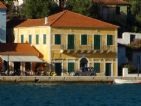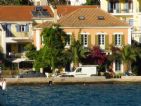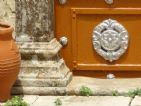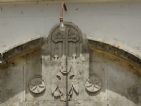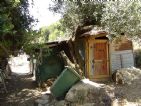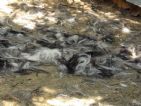
Ithaca. (General Part)
13/06/2013
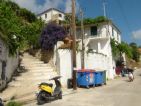 We will star this General Part of Ithaca sharing some notes on architecture. The Archduke left us several drawings with some of the houses he saw in his stay in Ithaca. In Petalata area we could see one of those houses. It looks like it's been halved, changed the roofs, reinforced the terraces and expanded the staircase leading up to the house, although the house is still recognizable from the drawing of the Archduke.
We will star this General Part of Ithaca sharing some notes on architecture. The Archduke left us several drawings with some of the houses he saw in his stay in Ithaca. In Petalata area we could see one of those houses. It looks like it's been halved, changed the roofs, reinforced the terraces and expanded the staircase leading up to the house, although the house is still recognizable from the drawing of the Archduke.
Remember that whole Ionian area has suffered some major earthquakes and therefore is difficult to find some of the old houses. Yet we know that in the neighborhood of Karavata houses withstand better to the last of the great earthquakes. Here's some of the representative houses preserved in Karavata. One of them has been transformed into a bar restaurant.
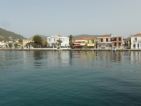 The building laws are very strict in Ithaca, as well as in other areas of the Ionian -as we have seen and admired-. In that sense it's pretty much like what we saw in the Lipari Islands in Italy. The heights are limited and they must always put the same kind of red roofs and wooden windows. Here we can see other houses in the downtown area.
The building laws are very strict in Ithaca, as well as in other areas of the Ionian -as we have seen and admired-. In that sense it's pretty much like what we saw in the Lipari Islands in Italy. The heights are limited and they must always put the same kind of red roofs and wooden windows. Here we can see other houses in the downtown area.
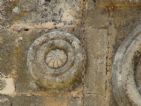 It also drew our attention the details of some of the churches we were seeing. The bell tower of the church of Anogi, which is Venetian style, has some details we can see in this picture. We can also see some details of the door of the church of Anogi.
It also drew our attention the details of some of the churches we were seeing. The bell tower of the church of Anogi, which is Venetian style, has some details we can see in this picture. We can also see some details of the door of the church of Anogi.
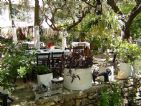 In terms of gastronomy, written by the Archduke, they used the "Tserepa" as the type of container to cook meat and fish -not just bread-. But today there are no longer made out of mud, but usually by metal. In Stavros we ate in the restaurant Polyphemus beef cooked with vegetables in a closed-paper which is also an alternative to the "Tserepa".
In terms of gastronomy, written by the Archduke, they used the "Tserepa" as the type of container to cook meat and fish -not just bread-. But today there are no longer made out of mud, but usually by metal. In Stavros we ate in the restaurant Polyphemus beef cooked with vegetables in a closed-paper which is also an alternative to the "Tserepa".
We have also seen in restaurants pies filled with vegetables, spinachs, onions, etc.. And also they still cook some of the sauces which indicated the Archduke as the "Skordalja". In the restaurants they often serve aubergines sauces or purees and beetroot with garlic and fish roe. As for the sweets we could taste the "halvah" made with flour, wine and honey.
As for the dresses, nowadays most people wear occidental mode. Only in small towns you can find some ladies who dress all in black with their hair under a scarf. We visited the Museum of Vathy and we saw the traditional dresses of Ithaca. Also we saw the old captain's suit, since Vathy has a great seafaring tradition.
As for economic activities today we see that people work much less in primary activities. It continues to produce oil and wine but these are usually small productions for private use and to supply local markets and restaurants or bars.
Most people are engaged in tertiary activities and particular in tourism. We note in the "tourist-mix" of Ithaca leads the renting of houses to tourists with high economic level. There are also some places specializing in elite-VIP tourism as Skino, which often hosted Hollywood stars. It is therefore very little crowded. We are only able to talk about overcrowding at the sea in the times when nautical charters and private boats -mostly Greek and Italian- come to the place.
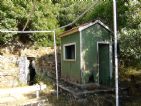 Surprises us finally the degree of carelessness of some infrastructure, such as roads and ports, and some sightseeing. For example, we were surprised to visit the cave of the nymphs and find it abandoned and the caretaker's cottage destroyed, or visit the ruins of Alalcomenae and find a goats cabin. Yet both the degree of preservation of the nature of the island and its traditional architecture makes Ithaca a wonderful place.
Surprises us finally the degree of carelessness of some infrastructure, such as roads and ports, and some sightseeing. For example, we were surprised to visit the cave of the nymphs and find it abandoned and the caretaker's cottage destroyed, or visit the ruins of Alalcomenae and find a goats cabin. Yet both the degree of preservation of the nature of the island and its traditional architecture makes Ithaca a wonderful place.
So far some of the data we have collected. In the comparison we made after summer we'll add some more. We'll be back with the next entry on the west coast and southwest of Ithaca.








